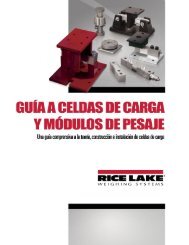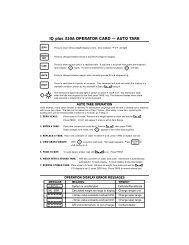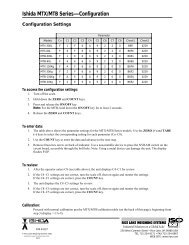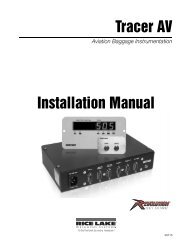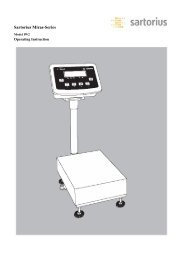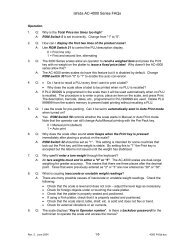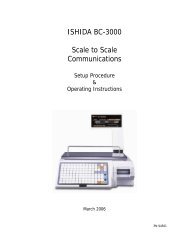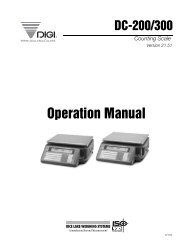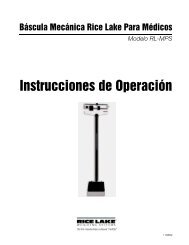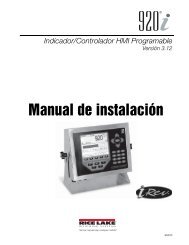SURVIVOR® 320HE - Rice Lake Weighing Systems
SURVIVOR® 320HE - Rice Lake Weighing Systems
SURVIVOR® 320HE - Rice Lake Weighing Systems
Create successful ePaper yourself
Turn your PDF publications into a flip-book with our unique Google optimized e-Paper software.
SURVIVOR ® <strong>320HE</strong><br />
IQ plus ® 310A Installation and Operation Man u al<br />
1. The separate display board of the SURVIVOR <strong>320HE</strong> is driven by RS-232 serial data from the EDP port<br />
of the IQ plus 310A in di ca tor. Therefore, the EDP serial port is not available to operate any other pe ripher<br />
al devices.<br />
The indicator’s printer port can send serial data to peripheral equipment like printers or data collection<br />
devices. The printer port is hard-wired to a 3-position terminal block labeled for your convenience. Either<br />
simplex RS-232 or simplex 20 mA current loop is available at that terminal. The cord grip for that terminal<br />
has a re mov able plug installed to retain NEMA 4 sealing. If using the printer port terminal to output<br />
data, remove the plug before inserting the cable.<br />
2. This unit has been factory-configured to operate with the display board, and four of the default settings<br />
pub lished in the menu chart on pages 2 and 3 of this IQ plus 310A manual addendum have been changed.<br />
Please note the changes in defaults listed below:<br />
EDP Menu<br />
MODE = STREAM<br />
BAUD = 4800<br />
FORMAT = AN5316<br />
EOL DLY = SYNC<br />
Note:<br />
If the LCD display is not com mu nicat<br />
ing with the indicator, ERROR is<br />
dis played. If you receive an error, go<br />
into setup mode and verify that the<br />
above settings are being used.<br />
WARNING!<br />
HIGH VOLTAGE<br />
T POWER BEFORE SERVICING<br />
ZERO<br />
GROSS<br />
NET<br />
SHEILD<br />
+EXCITATION<br />
RED<br />
TARE<br />
+SENSE<br />
YELLOW<br />
-EXCITATION<br />
BLACK<br />
UNITS<br />
-SENSE<br />
BLUE<br />
+SIGNAL<br />
GREEN<br />
WHITE<br />
-SIGNAL<br />
PRINT<br />
SETUP<br />
SWITCH<br />
3. The head of one of the machine<br />
screws holding the SURVIVOR<br />
<strong>320HE</strong> en clo sure cover closed has<br />
a hole drilled through it to accept a<br />
wire from a legal-for-trade seal. This<br />
assures that the configuration will<br />
not change after certification.<br />
AC NEUTRAL<br />
AC LINE<br />
AC GROUND<br />
SHEILD<br />
+EXCITATION<br />
+SENSE<br />
-EXCITATION<br />
-SENSE<br />
+SIGNAL<br />
-SIGNAL<br />
+RED<br />
RS232<br />
-BLACK<br />
SIG GND<br />
+GREEN<br />
20mA<br />
Note:<br />
The unit is set at factory with<br />
jump ers installed to accept a<br />
4-wire load cell cable. If 6-wire<br />
cable with sense lines is to be<br />
used, remove jumpers from<br />
+EXC/+Sense and -EXC/-Sense<br />
terminal pairs.<br />
3 2<br />
1<br />
SW1<br />
SW2<br />
SW3<br />
EDP RECEIVE<br />
GROUND<br />
EDP TRANSMIT<br />
SW4<br />
6 5 4 3 2 1 12 11 10 9 8 7 6 5 4 3 2 1<br />
COMMON<br />
PRINT<br />
UNITS<br />
TARE<br />
NET/GROSS<br />
ZERO<br />
SW5<br />
34952<br />
10/96<br />
1
SETUP<br />
DIG IN<br />
EDP<br />
PRINTER<br />
ZERO<br />
GROSS<br />
NET<br />
ENTER<br />
TARE<br />
UNITS<br />
KEY FUNCTIONS IN SETUP MODE<br />
PRINT<br />
NOTE: Choices in bold type<br />
are the factory default settings.<br />
MODE<br />
BAUD<br />
BITS<br />
TICKET DEMAND STREAM<br />
7 ODD 7 EVEN 8 NONE<br />
1200 19200 9600 4800 2400<br />
MODE<br />
BAUD<br />
BITS<br />
TERMIN<br />
DEMAND TICKET STREAM 8 NONE 7 ODD 7 EVEN<br />
9600 4800 2400 1200 19200 CR/LF CR LF<br />
DIGIN 1<br />
DIGIN 2<br />
ZERO G/N TARE UNITS PRINT TEST HLD CLR<br />
ZERO G/N TARE UNITS PRINT TEST LK KEYS<br />
GRADS DEC PNT DSP DIV UNITS DFILT 1 - DFILT 3<br />
XXXXX 8888888<br />
Default: 8888880<br />
10,000<br />
8888800<br />
8.888888<br />
Max:<br />
88.88888<br />
60,000 888.8888<br />
8888.888<br />
88888.88<br />
888888.8<br />
1 2 5<br />
OFF 2 4 8 16 32 64 128 256<br />
LB KG TON T GRAM GRAIN OZ NONE<br />
TARE RS TARE FN G / B DECFRMT<br />
REGULT INDUST<br />
GROSS BRUTTO<br />
AUTO IN/OUT 888.8888 888,8888<br />
2
PTICKET<br />
ETICKET<br />
CALIBRT<br />
ZERO<br />
SPAN<br />
TW SPAN<br />
RE-ZERO<br />
0010000 UP DOWN<br />
100 (min.) to 60,000 (max.)<br />
<br />
<br />
FIELD 1<br />
GROSS NET TARE BLANK<br />
FIELD 2 FIELD 3 FIELD 4<br />
NET TARE BLANK GROSS<br />
TLE 01<br />
LSP 00<br />
TARE BLANK GROSS NET<br />
TLE 01<br />
LSP 00<br />
BLANK GROSS NET TARE<br />
TLE 01<br />
TLE 01<br />
LSP 00<br />
LSP 00<br />
FIELD 1<br />
FIELD 2 FIELD 3 FIELD 4<br />
GROSS NET TARE BLANK<br />
NET TARE BLANK GROSS<br />
TARE BLANK GROSS NET<br />
BLANK GROSS NET TARE<br />
TLE 01<br />
LSP 00<br />
TLE 01<br />
LSP 00<br />
TLE 01<br />
LSP 00<br />
TLE 01<br />
LSP 00<br />
TERMIN<br />
EOL DLY<br />
FORMAT<br />
CASE<br />
PRINTER<br />
CR/LF CR LF<br />
SYNC 0MS ..... 2.25 SEC<br />
MIXED LOWER UPPER<br />
CC WI120 CAR738 AN5316 T8142 T8142CK REMOTE<br />
GENERIC TM290 TM290RV<br />
EOL DLY<br />
FORMAT<br />
CASE<br />
PRINTER<br />
RESPOND<br />
0MS ..... 2.25 SEC SYNC<br />
MIXED LOWER UPPER<br />
ENABLE DISABLE STATUS<br />
CC WI120 CAR738 AN5316 T8142 T8142CK REMOTE<br />
GENERIC TM290 TM290RV<br />
DF THRH<br />
DF SENS<br />
MOT BAND ZRANGE ZEROTRK OVRLOAD PWR UP<br />
2 OUT ... 8 OUT ... 128<br />
2% 100%<br />
FS+2% FS FS+1d FS+9d<br />
NONE 2DD ..... 250DD<br />
1d 2d 3d OFF<br />
OFF 0.5d 1d 2d 3d<br />
GO DELAY<br />
UPDATE<br />
ZERO KY<br />
TARE KY<br />
UNIT KY<br />
PRNT KY<br />
KEYBRD<br />
250 ms ... 4 sec<br />
ENABLE DISABLE<br />
ENABLE DISABLE<br />
ENABLE DISABLE<br />
ENABLE DISABLE<br />
ENABLE DISABLE<br />
3
SETUP MENU DESCRIPTIONS<br />
Factory default settings are shown in the following charts in bold type with a √. The two-letter<br />
code in pa ren the ses beneath each parameter name is the EDP command for that pa ram e ter.<br />
NAME/CODE DESCRIPTION CODE/VALUE<br />
GRADS<br />
(GR)<br />
DEC PNT<br />
(DP)<br />
DSP DIV<br />
(DD)<br />
Specifies number of full scale graduations. Value should be<br />
con sis tent with legal requirements and environmental limits on the<br />
useful system resolution.<br />
Determines location of decimal point or dummy zeros. Code 6<br />
has no decimal point. Codes 7 and 8 have no decimal point and<br />
one and two dummy zeros respectively. Value should be consistent<br />
with legal requirements. This number may be modified<br />
automatically by the indicator when the UNITS key (or equivalent<br />
EDP command) is used to display alternate units.<br />
Specifies display division size—the number that GRADS are mul tiplied<br />
by to give the displayed weight. This number is equal to the<br />
full scale capacity divided by the number of full scale graduations.<br />
This number may be modified automatically by the indicator when<br />
the UNITS key (or equivalent EDP command) is used to display<br />
al ter nate units.<br />
0 to 60,000<br />
Default = 10,000√<br />
0 = 8.888888<br />
1 = 88.88888<br />
2 = 888.8888<br />
3 = 8888.888<br />
4 = 88888.88<br />
5 = 888888.8<br />
6 = 8888888 √<br />
7 = 8888880<br />
8 = 8888800<br />
0 = 1 √<br />
1 = 2<br />
2 = 5<br />
UNITS<br />
(UN)<br />
Specifies the units for displayed and printed weight.<br />
0=LB √<br />
1=KG<br />
2=TON<br />
3=T*<br />
*(metric)<br />
4=GRAM<br />
5=GRAIN<br />
6=OZ<br />
7=NONE<br />
DFILT1<br />
(F1)<br />
DFILT2<br />
(F2)<br />
DFILT3<br />
(F3)<br />
DF THRH<br />
(FL)<br />
Sets each of the three digital filter stages to a value rep re sent ing<br />
the number of A/D readings over which an average is calculated.<br />
Set ting DFILT1 automatically sets DFILT2 and DFILT3 to the same<br />
value unless DFILT2 and DFILT3 are then changed in de pen dent ly<br />
to achieve intermediate values. The lowest value (OFF-OFF-OFF)<br />
pro vides the quickest response. The higher the number, the<br />
heavier the digital filtering and slower the response time.<br />
Filtering values may be modified via EDP commands in either<br />
SETUP or OPERATING modes.<br />
See Section 7.2 for more complete information on setting digital<br />
filtering.<br />
F1 F2 F3<br />
OFF OFF OFF No Filtering<br />
2 2 2<br />
4 4 4<br />
8 8 8<br />
16 16 16<br />
32 32 32<br />
64 64 64<br />
128 128 128<br />
256 256 2356 Heaviest Filtering<br />
Filter cutout threshold. Selects the threshold, in display divisions,<br />
beyond which the digital filtering will cut out. If a specified number<br />
(see DF SENS) of con sec u tive readings are outside the specified<br />
thresh old around the cur rent ly displayed value, the indicator<br />
will jump immediately to the most recent value, ignoring filtering.<br />
“NONE” disables threshold checking.<br />
0 = OFF √<br />
1 = 2<br />
2 = 4<br />
3 = 8<br />
4 = 16<br />
5 = 32<br />
6 = 64<br />
7 = 128<br />
8 = 256<br />
0 = NONE √<br />
1 = 2 DD<br />
2 = 5 DD<br />
3 = 10 DD<br />
4 = 20 DD<br />
5 = 50 DD<br />
6 = 100 DD<br />
7 = 200 DD<br />
8 = 250 DD<br />
4
SETUP MENU DESCRIPTIONS (CONTINUED)<br />
NAME/CODE DESCRIPTION CODE/VALUE<br />
DF SENS<br />
(FS)<br />
MOT BAND<br />
(MB)<br />
ZRANGE<br />
(ZR)<br />
ZEROTRK<br />
(ZT)<br />
OVRLOAD<br />
(OV)<br />
PWR UP<br />
(PU)<br />
TARE RS<br />
(TR)<br />
Filter cutout sensitivity. Selects the number of consecutive readings<br />
that must fall outside the threshold (see DF THRH) before digital<br />
filtering is ig nored and the indicator jumps directly to the new value.<br />
Selects the Motion Band, the level at which motion is detected by<br />
comparing the present weight reading with the previous one. If<br />
motion is not de tect ed for one second or more, the Standstill annun<br />
ci a tor lights. When "OFF," is selected, conditions for Standstill<br />
are always met, but the annunciator does not light. Max i mum<br />
value varies depending on local regulations.<br />
Zero Range: Selects the range within which the scale may be<br />
zeroed. The 2% selection is ±2% around the calibrated zero point,<br />
for a total range of 4%. Indicator must be in Standstill to ZERO the<br />
scale. Use 2% for legal-for-trade scales.<br />
Zero Track Band: Automatically zeroes range of selected value, as<br />
long as the input is within ZRANGE, and scale is in Standstill. Selec<br />
tions are ±dd. Maximum value varies with local regulations.<br />
Overload: Determines the point at which the display blanks and an error<br />
message is displayed, indicating an out-of-range condition. For Legal-<br />
For-Trade scales, the setting is determined by local regulations.<br />
Power Up Mode: In the GO mode, the scale goes into operation imme<br />
di ate ly after the power up test sequence. In the DELAY mode,<br />
the word "DELAY" and a simulated clock appear for 60 seconds. If<br />
motion is detected during the delay period, the sequence restarts.<br />
On power up, the display is always in GROSS mode. The delay is<br />
required by HB-44 if the scale is not capable of achieving legal ac-<br />
Tare Restriction: "Regulated" requires that the scale be in standstill<br />
and the gross weight be in the range between 1 grad and Full Scale<br />
to acquire tare. "Industrial" allows any displayable gross weight to<br />
be acquired as a tare. There is no restriction for entering a tare value<br />
0 = 2 OUT<br />
1 = 4 OUT<br />
2 = 8 OUT √<br />
3 = 16 OUT<br />
4 = 32 OUT<br />
5 = 64 OUT<br />
6 =128 OUT<br />
0 = OFF<br />
1 = 1dd √<br />
2 = 2dd<br />
3 = 3dd<br />
0 = 2% √<br />
1 = 100%<br />
0 = OFF √ 3 = 2dd<br />
1 = .5dd 4 = 3dd<br />
2 = 1dd<br />
0 = Full Scale<br />
1 = FS + 1dd<br />
2 = FS + 9dd<br />
3 = FS + 2% √<br />
0 = GO √<br />
1 = DELAY<br />
0 = INDUST<br />
1 = REGULT √<br />
TARE FN<br />
(TF)<br />
G/B<br />
(GB)<br />
Tare Function: An entered tare remains in memory in the system for<br />
subsequent weighings. "Auto" mode allows additional weight to be<br />
"tared off" by pressing the TARE key again in either G or N mode.<br />
Removing a tare value in "Auto" mode requires pressing the TARE<br />
key when the scale reads "0" in Gross Weight. With "In/Out" mode,<br />
the tare value is removed by pressing the TARE key a second time<br />
with the scale in either G or N.<br />
Selects "G" (Gross) or "B" (Brutto) as the annunciator for the<br />
Gross Weight. This affects both the displayed and printed weights.<br />
0 = AUTO √<br />
1 = IN/OUT<br />
0 = GROSS√<br />
1 = BRUTTO<br />
DECFRMT<br />
(DF)<br />
Decimal point format. Allows specification of a comma instead of<br />
the default period to be used as a decimal point.<br />
0 = 8888.888√<br />
1 = 8888,888<br />
5<br />
Continued
SETUP MENU DESCRIPTIONS (CONTINUED)<br />
NAME/CODE<br />
UPDATE<br />
(UR)<br />
ZERO KY<br />
(LZ)<br />
TARE KY<br />
(LT)<br />
DESCRIPTION<br />
Display Update Rate: Selects the time between display<br />
updates. The motion detector can be made more sensitive<br />
to small changes by increasing the update time, according to<br />
the op er a tor's preference.<br />
ENABLE or DISABLE the Zero Key. The LZ1 or LZ0 EDP commands<br />
will be accepted at any time. However, different locks<br />
are set or reset depending on whether the indicator is in SET-<br />
UP or OP ER ATE mode. If either lock is on, the key is disabled.<br />
ENABLE or DISABLE the Tare Key. The LT1 or LT0 EDP commands<br />
will be ac cept ed at any time. However, different locks<br />
are set or reset depending on whether the indicator is in SET-<br />
UP or OP ER ATE mode. If either lock is on, the key is disabled.<br />
CODE/VALUE<br />
0 = 250ms √ 5 = 2 sec<br />
1 = 500ms 6 = 2.5sec<br />
2 = 750ms 7 = 3 sec<br />
3 = 1 sec 8 = 4 sec<br />
4 = 1.5 sec<br />
0 = ENABLE √<br />
1 = DISABLE<br />
0 = ENABLE √<br />
1 = DISABLE<br />
UNIT KY<br />
(LU)<br />
ENABLE or DISABLE the Units Key. The LU1 or LU0 EDP commands<br />
will be ac cept ed at any time. However, different locks are<br />
set or reset depending on whether the indicator is in SETUP or<br />
OPERATE mode. If either lock is on, the key is disabled.<br />
0 = ENABLE √<br />
1 = DISABLE<br />
PRNT KY<br />
(LP)<br />
KEYBRD<br />
(LK)<br />
ENABLE or DISABLE the Print Key. The LP1 or LP0 EDP commands<br />
will be accepted at any time. However, different locks<br />
are set or reset de pend ing on whether the indicator is in SETUP<br />
or OPERATE mode. If either lock is on, the key is disabled.<br />
ENABLE or DIS ABLE all front panel keys. The LK1 or LK0 EDP<br />
commands will be accepted at any time. However, different<br />
locks are set or reset depending on wheth er the indicator is in<br />
SETUP or OPERATE mode. If either lock is on, the front panel<br />
keys are disabled (while in OPERATE mode).<br />
0 = ENABLE √<br />
1 = DIS ABLE<br />
0 = ENABLE √<br />
1 = DISABLE<br />
DIGITAL INPUT MENU DESCRIPTIONS<br />
Up to two external switches can be wired into the digital input connections on the J4 ter minal<br />
of the main board (See Figure 8 in manual). Each switch can be pro grammed to du pli cate<br />
the normal functions of any front panel key. For instance, a switch could remotely "press" the<br />
PRINT key through a digital input channel. The switches could also be pro grammed to perform<br />
Lock Keyboard or Hold/Clear func tions. The KEY LK (Keyboard Lockout) se lec tion locks<br />
out the key functions in the normal operation mode. These are the Zero, Gross/Net, etc., key<br />
func tions. It does not lock the keys in the Setup Mode. The HLD CLR (Hold/Clear) se lec tion for<br />
Input 2 holds the display and clears the run ning av er age filter. The Print function and EDP commands<br />
XG, XN and XT process the Hold val ues. The con tin u ous serial output continues, sending<br />
the weight and status information captured when the Hold/Clear function was initiated.<br />
NAME/CODE DESCRIPTION CODE/SELECTION<br />
DIGIN 1<br />
(IA)<br />
DIGIN 2<br />
(IB)<br />
Duplicates function of ZERO key<br />
Duplicates function of GROSS/NET key<br />
Duplicates function of TARE key<br />
Duplicates function of UNITS key<br />
Duplicates function of PRINT key<br />
Duplicates function of TEST key<br />
Locks out keyboard (IA only)<br />
Holds display and clears running average filter (IB only)<br />
0 = ZERO √<br />
1 = GROSS/NET<br />
2 = TARE<br />
3 = UNITS<br />
4 = PRINT<br />
5 = TEST<br />
6 = LOCK KEYBD (IA)<br />
6 = HOLD/CLEAR (IB)<br />
6
EDP (ELECTRONIC DATA PROCESSING PORT) MENU DESCRIPTIONS<br />
NAME/CODE DESCRIPTION CODE/SELECTION<br />
MODE<br />
(EM)<br />
BAUD<br />
(EB)<br />
BITS<br />
(EP)<br />
Selects the transmission mode of the EDP Port. In DEMAND<br />
the port is quiet on power-up, but continuous data can be<br />
started and stopped with the SX and EX commands. In<br />
TICKET, the port transmits data as for mat ted in the ETICKET<br />
Menu. In STREAM, the port trans mits the selected data format<br />
con tin u ous ly, starting automatically on power-up.<br />
Selects the transmission speed.<br />
Selects the number of data bits and parity of transmitted<br />
0 = STREAM<br />
1 = DEMAND √<br />
2 = TICKET<br />
0=9600 √ 3=1200<br />
1=4800 4=19200<br />
2=2400<br />
0=8 NONE √ 1=7 ODD<br />
2=7 EVEN<br />
TERMIN<br />
(EE)<br />
EOL DLY<br />
(ED)<br />
FORMAT<br />
(EF)<br />
CASE<br />
(EA)<br />
PRINTER<br />
(EK)<br />
RESPOND<br />
(ER)<br />
End of Line Termination Characters: carriage return only, line<br />
feed only, or both carriage return and line feed options.<br />
The specified characters will be appended to each streamed<br />
serial output line for CC, WI120, AN5316, and REMOTE<br />
formats (not CAR738, T8142, or T8142CK formats). These<br />
characters will also be sent for each trailing line end specified<br />
for the lines of a ticket if the printer type selected is GENERIC<br />
(not TM290 or TM290RV).<br />
End of Line Delay. The delay period in milliseconds from<br />
when a line is terminated to the beginning of the next formatted<br />
printer output. Both the PRINT button and the EDP Print<br />
command (PR) are disabled during this delay period. This sets<br />
the EDP port update rate.<br />
“SYNC” synchronizes streamed serial output to the display<br />
update. If the port is in ticket mode, the end of line delay for<br />
each line will be equal to the display update interval. (The<br />
display is not changed while a ticket is being printed)<br />
Serial string format of continuous EDP port trans mis sion. See<br />
Section 6.4 for exact data formats available.<br />
Allows alphabetic output to the EDP port to be forced to<br />
either all upper case or all lower case.<br />
Indicates the type of ticket printer (if any) connected to the<br />
EDP port. The setting of this parameter only has meaning if<br />
the EDP port is in TICKET mode.TM290 and TM290RV select<br />
the TM290II ticket print er operating in normal or reverse<br />
Allows disabling of the EDP port acknowlegment (“Ok” or<br />
“??”) transmissions (see also the “NK” operating command<br />
in Section 6.3 of the manual).<br />
0 = √<br />
1 = <br />
2 = <br />
0=0ms √<br />
1=250ms<br />
2=500ms<br />
3=750ms<br />
4=1000ms<br />
5=1250 ms<br />
6=1500 ms<br />
0 = CC √<br />
1 = WI120<br />
2 = CAR 738<br />
3 = AN 5316<br />
4 = T8142<br />
5 = T8142CK<br />
6 = REMOTE<br />
0 = MIXED √<br />
1 = LOWER<br />
2 = UPPER<br />
0 = GENERIC √<br />
1 = TM290<br />
2 = TM290RV<br />
0 = ENABLE √<br />
1 = DISABLE<br />
7=1750 ms<br />
8=2000 ms<br />
9=2250 ms<br />
A=SYNC<br />
7
PTICKET AND ETICKET FORMAT MENU DESCRIPTIONS<br />
Two separate menus allow speification of the format of weight tickets—PTICKET for<br />
tickets sent to the printer port, and ETICKET for tickets transmitted via the EDP port.<br />
The line end characters to be sent are specified using the TERMIN parameters in each<br />
menu.<br />
The ticket format pa ram e ters in the table fol low ing de ter mine the for mat of up to four<br />
fields of data print ed on a weight ticket. Each field may contain the Gross, Tare or Net<br />
value, be Blank or Display the current value (gross or net). Each field is lo cat ed hor i-<br />
zon tal ly by en ter ing a num ber of lead ing spac es (LSP) and ver ti cal ly by en ter ing a number<br />
of trail ing line ends (TLE). The trail ing line ends in the last field may also be used to<br />
NAME/CODE DESCRIPTION CODE/SELEC-<br />
FIELD 1, 2, 3<br />
or 4<br />
(PT) or<br />
(ET)<br />
(f = field #)<br />
(x = code)<br />
TLExx<br />
(PC) or<br />
(ET)<br />
(f = field #)<br />
(xx = code)<br />
LSPxx<br />
(PS)<br />
or<br />
(ES)<br />
(f = field #)<br />
Specifies information printed in each field.<br />
Default Settings:<br />
Field 1 = GROSS, Field 2 = TARE, Field 3 = NET, Field 4 = BLANK<br />
Example: To change Field 3 to Tare, enter TARE code (3) for pa rame<br />
ter FIELD 3 (or send EDP command PT33).<br />
Trailing Line Ends: Number of line end sequences (TERMIN) sent<br />
fol low ing the selected field. Specific number (xx) must be entered<br />
via keyboard (see Section 3.2).<br />
Example: To specify 3 carriage returns for Field 1, enter 3 for param<br />
e ter TLE (or send EDP com mand PC13).<br />
Leading Spaces: Number of leading spaces preceding the selected<br />
field. Specific number (xx) must be entered via keyboard.<br />
Example: To specify 31 leading spaces in Field 3, enter 31 for param<br />
e ter LSP under FIELD 3 (or send EDP command PS331).<br />
0 = BLANK<br />
1 = GROSS<br />
2 = NET<br />
3 = TARE<br />
4 = DISPLAY (DIS-<br />
PLAY Selects the<br />
displayed value,<br />
whether gross or<br />
net).<br />
xx = 0 to 99<br />
Default = 1 √<br />
xx = 0 to 99<br />
Default = 0 √<br />
6 LEADING<br />
SPACES<br />
FIELD 1<br />
FIELD 2<br />
FIELD 3<br />
15012 lb G<br />
12 lb T<br />
15000 lb N<br />
NOTE: PRINTED NUMERIC FIELD CONTAINS<br />
NINE CHARACTER SPACES. PRINTS ONE<br />
SPACE BEFORE "lb" AND ONE BEFORE "G".<br />
2 TRAILING LINE ENDS<br />
PRINTED TICKET<br />
FIELD 4<br />
4 TRAILING LINE ENDS.<br />
LAST LINE END ADVANCES<br />
PRINTER TO NEXT TICKET .<br />
SAMPLE SET-UP FOR PRINTER TICKET<br />
8
DIGITAL FILTERING<br />
PRINCIPLES OF OPERATION<br />
The IQPLUS 310A uses a three-stage averaging digital filter with an adjustable cutout<br />
thresh old and sensitivity to reduce the effect of vibration on weight readings while allowing<br />
quick settling when a weight is placed on the scale.<br />
There are three filtering controls—averaging (DFILT), a cutout threshold (DF THRH), and a<br />
cutout sensitivity (DF SENS).<br />
The averaging controls (DFILT 1—DFILT 3) are tunable cascaded stages controlling the effect<br />
that a single A/D reading has on the cur rent displayed weight. By default, DFILT 2 and<br />
DFILT 3 will acquire the same setting as DFILT 1 unless they are individually set to different<br />
values.<br />
• A setting of OFF for all three stages disables averaging. It pro duc es a 1-in-1 effect,<br />
so the cur rent A/D reading is simply the dis played weight (1 x 1 x 1).<br />
• An intermediate setting, for example 8, 8, 8, produces an averaging effect such that<br />
each A/D reading has a 1-in-512 effect on the displayed weight (8 x 8 x 8).<br />
• A setting of 256 for all three stages produces the heaviest filtering. At that level,<br />
each A/D read ing has less than a 1-in-16 million effect on the cur rent dis played<br />
weight (256 x 256 x 256).<br />
By itself, the digital filter can be used to eliminate the effects of vibration, but heavy filtering<br />
significantly increases the settling time. In fact, the display may take several seconds<br />
to settle at the highest filtering settings. To over come this, the Cutout Thresh old and Cutout<br />
Sen si tiv i ty con trols are pro vid ed al low ing you to specify a threshold (in display di visions)<br />
and a sen si tiv i ty “n” (in numbers of read ings).<br />
• If “n” consecutive readings are be yond the threshold, fil ter ing will cutout, or be<br />
disabled, until the scale has settled. (Note that because vibration may not allow the<br />
scale to go to stand still while filtering is dis abled, the settling detection is not the<br />
same as motion de tec tion. The scale may still be “in motion” when filtering is reenabled).<br />
SETTING FILTERING CONTROLS<br />
To set filtering controls, first determine the maximum vibration effects present by running<br />
DFILT 1—3 with no filtering (OFF, OFF, OFF) and an empty scale (or displaying a zero net).<br />
Watch the dis play and record the num ber below which all but a few of the variations fall.<br />
Con vert this weight reading to dis play divisions (max i mum weight reading divided by your<br />
dis play division size — 1, 2, or 5 — equals total dis play divisions caused by vibration). You<br />
will use this num ber of display di vi sions when setting the final cutout thresh old<br />
(DF THRH). Just record the number for now, leaving the DF THRH set to NONE.<br />
With the DF THRH level set to NONE, adjust the three averaging controls (DFILT 1—3) to<br />
elim i nate the effects of vi bra tion on the readings. Set these as low as pos si ble. Higher settings<br />
will increase the settling time in the vicinity of the target weight.<br />
Now set the filter cutout level (DF THRH) using the value you calculated above.<br />
Then set the cutout sensitivity value (DF SENS) high enough to ignore transient peaks. The<br />
longer the du ra tion of the peaks (typically, the lower the vibration fre quen cy), the higher the<br />
9



